Cheung fun (肠粉) is on the menu of every Dim Sum restaurant. It is a popular classic dim sum dish apart from the famous triumvirate of dim sum quintessential- Shrimp Dumpling, Shumai, and Char Siu Bao.
Cheung fun has a light and soft texture, non-oily, and is served hot right from the steamer. You only need simple ingredients to make it, primarily a batter of rice flour and some shrimp and char siu or served right with a savory sauce consisting of premier-grade soy sauce and some sugar. This lightly flavored dim sum is most suitable to satisfy the palate of diners during breakfast, who prefer food that is light and easy to digest.
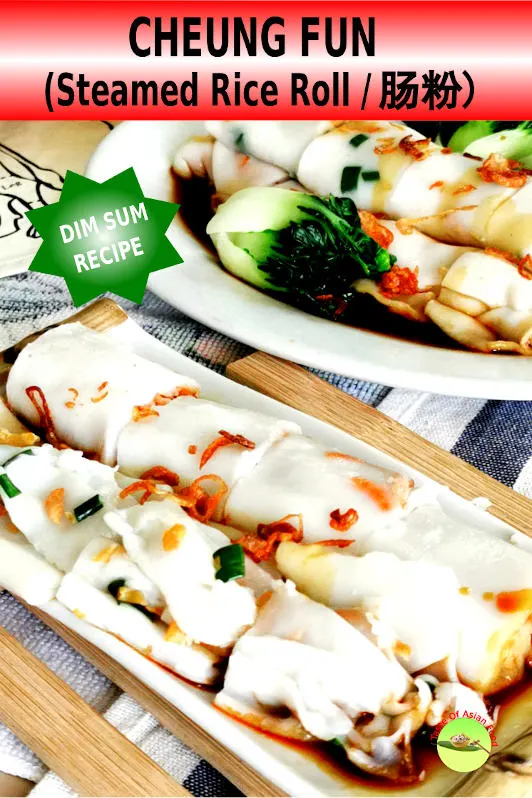
The dim sum chef in the restaurant uses a tailor-made steamer with a large cover and cotton cloth (the unique kitchen tool). In this article, I want to explore the best way to make Cheung Fun at home of the same quality as the restaurant. It must be quick and easy; otherwise, I prefer enjoying the nearest dim sum store without going through the hassle of making it myself.
Note: Cheung fun is also called chee Cheung fun, Cheong fun, steamed rice roll, or 猪肠粉, the same rice noodles.
Note: This post may contain affiliate links. Please read my privacy policy for more info. I may receive commissions for purchases made through links in this post. As an Amazon Associate, I earn from qualifying purchases.
1. How to prepare Cheung Fun at home
Below is the step-by-step guide to making the Cheung Fun (rice noodles sheets). This recipe will yield the Cheung Fun, similar to those you enjoy in the Hong Kong Dim Sum restaurants.
Here are the steps :
- Mix the rice flour, wheat starch, salt, vegetable oil, and water in a container.
- Set up the steaming station.
- Apply some oil onto the baking pan, or you can use a small nonstick square cake pan instead.
- Measure 100g of the batter. It is the amount required for an 8″ x8″ square pan. Make sure to stir the batter before pouring it because the flour and starch will quickly sink to the bottom.
- Bring the water to a boil.
- Pour the flour mixture into the pan. Adjust the level of the pan so that the batter is equally distributed.
- Add the filling of your choice (shrimp, char siu, or scallion with dried shrimp) to one side of the batter. You do not need to wait until it is solidified before adding the ingredients. However, it should be a single layer so that the filling is embedded firmly into the noodle sheet.
- Cover and steam for 2 minutes or until the rice sheet become translucent.
- Remove the pan from the steamer with a steamer gripper.
- Let cool for half a minute, then push the noodle sheet with the dough scraper to roll up the noodle.
- Place it on the serving dish and douse with the sauce.
- Sprinkle sesame seeds on top to serve. Some people may also add some thinly sliced spring onion.
2. Common fillings for Hong Kong-style Cheung Fun
The most common filling for the Hong Kong Style Cheung Fun is shrimp and Char Siu. Another popular variation where I live is scallion with dried shrimp.
a) Marinate the shrimp
- Clean, unshelled and devein the shrimp as usual.
- Wash it with plenty of water until the water runs clear.
- Add some baking soda and salt and marinate the shrimp for half an hour. Baking soda increases the shrimp’s pH, helps retain moisture, and makes it look plump; salt makes it more crunchy.
- Wash away the baking soda and the extra salt.
- Please give it a few rough chops so it is small enough to stick firmly on the noodle sheet during steaming.
b) Use store-bought char siu (or make it yourself)
I suggest you use the store-bought Char Siu to save time. Please refer to this article if you’d like to make it yourself.
c) Ingredients for the green onion and dried shrimp Cheung Fun
- Cut the scallion into small rings.
- Soak the dried shrimp in hot water for 10 minutes. Remove any debris and shell that may present. Drain.
- Coarsely chopped the dried shrimps, and it is ready to use.
3. Prepare the sauce for Hong Kong Cheung Fun
The Cantonese Cheung Fun sauce mainly consists of light soy sauce and sugar. Also, sesame oil and oyster sauce are sometimes included, which is quite similar to Char Siu sauce’s taste. Dark soy sauce is rarely used in Hong Kong-style Cheung Fun.
I have tested a few combinations before finalizing the recipe for my Cheung Fun.
The Malaysian version is slightly different from the Hong Kong version. It is served with sweet sauce (甜酱) and chili sauce instead of soy sauce.
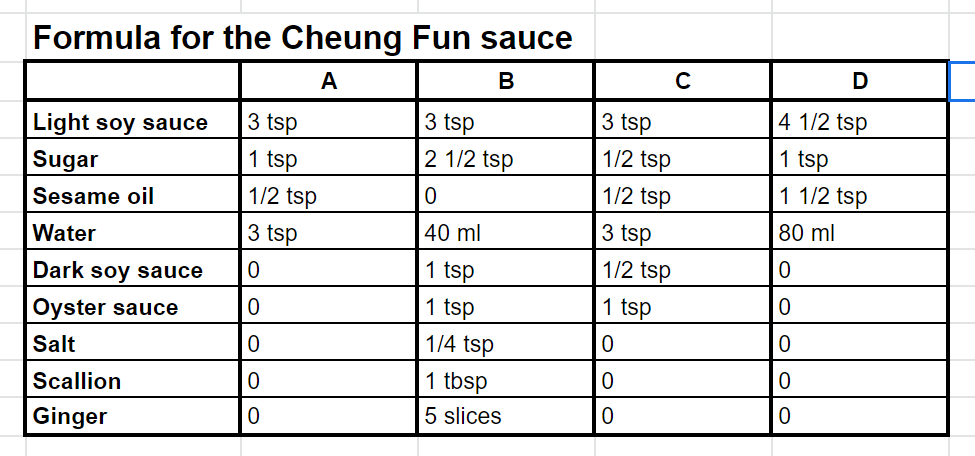
Formula B is the best, as the formula uses oyster sauce, scallion, and ginger. Formula A is also quite tasty and quick to make. Formula C and D are not desirable.
How to prepare the sauce:
It is straightforward to prepare the sauce. Just add all the ingredients to a small pan and bring it to a boil. For formula B, you must pass the sauce through a wire mesh strainer to remove the scallion and ginger.
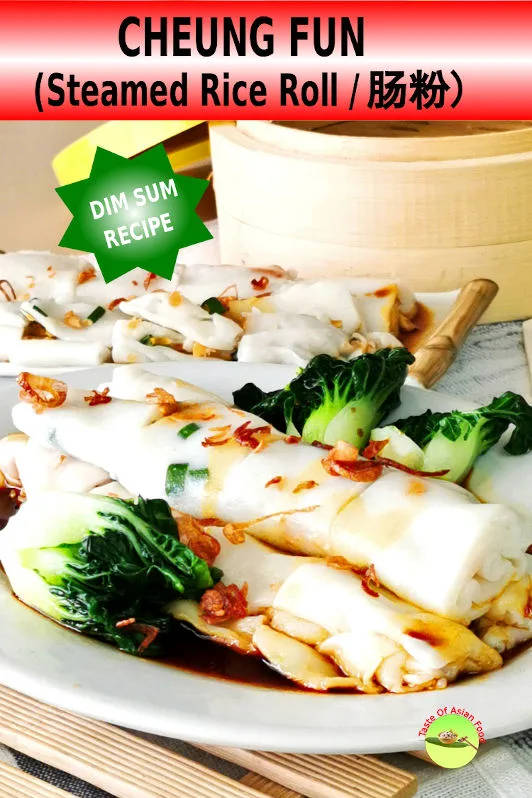
4. In search of the best recipe for Cheung Fun
If you search for the recipe for Cheung Fun on the internet, you will find different formulas for Cheung Fun. It ranges from using only water and rice to the more complicated one added with a range of starches.
a. Use rice flour to make Cheung Fun.
The make-from-scratch method involves soaking and grinding rice. I consider this is too much work for any home cook. Therefore, I choose to use ready-made rice flour instead. It is called 粘米粉 in Chinese and not to get confused with glutinous rice flour. This ingredient is available in most Asian grocery stores.
All you need is to add salt and oil to form a batter, spread it thinly on a pan, and steam it.
b. Two differences among the everyday recipes
The critical difference is the type of starch added to the rice batter. It can be corn, wheat, and tapioca starch. The amount varies from merely twenty percent of the rice flour to eighty percent.
The second difference is using a baking pan to steam the Cheung Fun versus the traditional method of pouring the batter on a cotton cloth.
5. How do I formulate my Cheung Fun recipe?
Curious to know the difference, I tested six different formulas by altering the amount and types of starch in the formulas. I also tried the impact of changing the amount of water in the batter. Finally, I tested the result using the cloth and pan methods with the same formula.
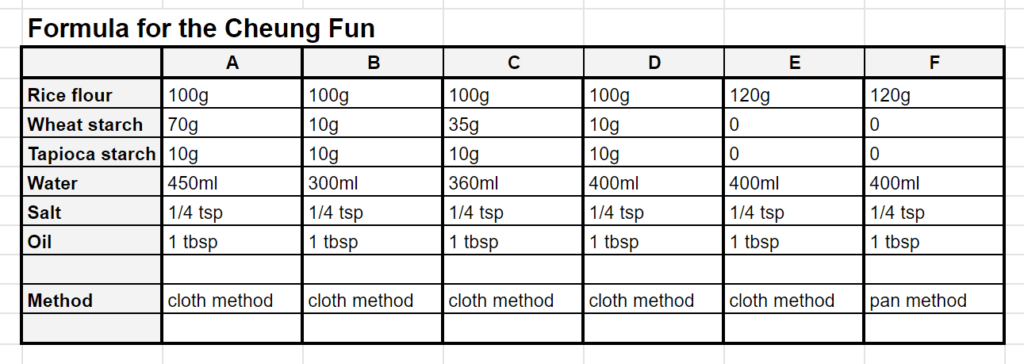
All the formulas tested are with the cloth method except Formula F. A taste test was carried out by five-person, and below is the result. Of course, this test is not a scientific study, but it does shed light on me to formulate the best recipe that suits me.
a. The result of my experiment:
- Formula A. It contains the highest amount of starch and has a very chewy texture.
- Formula B. The amount of starch is much lower (20% of the rice flour), which has a softer and less chewy texture. It is close to the surface of Cheung Fun in most Hong Kong-style dim sum restaurants.
- Formula C. The amount of starch is between formula A and B. It is still chewy, based on the consensus from the five of us.
- Formula D. The formula is identical to B, except the batter has more water. So far, this is the best formula. The texture is soft, nearly melts in the mouth, and slightly chewy.
- Formula E. There is no added starch in this formula. It is acceptable, but the texture is slightly softer than D.
- Formula F. The purpose of this formula is to test the quality of Cheung Fun of the same formula as the pan method. This formula is identical to E; the only difference is pouring the batter directly into a metal pan.
b. Interpretation of the result:
- The formula added with 20% starch yields the Cheung Fun closest to the texture of those served in the Cantonese dim sum restaurant.
- The type of starch does not significantly affect the texture and taste of the Chung Fun.
- Starch makes the Cheung Fun chewier, more resilient to force, and less likely to break.
- The amount of water in the batter affects the softness of the Cheung Fun. Therefore, the more watery batter will yield softer Cheung Fun.
- The texture is too soft if we do not add some starch into the batter, although the rice flour I used is already added with some corn starch (without mentioning the quantity on the package).
- The result of using the cloth method and pan method is quite identical.
- You can alter the amount of starch and water to achieve your desired texture. In short, the Cheung Fun with more starch is chewier, and more water is softer.
6. The cloth method versus the pan method- which is better?
Have you watched how to make this Cantonese dish in a dim sum restaurant?
They use a special rectangle steamer with perforated holes, big enough to make two servings of Cheung Fun. Some more prominent restaurants have two steamers. While the rice roll is cooked in the first steamer, he will add the batter to the second steamer. The concurrent use of two steamers can yield four rice rolls in 4 minutes.
I get the Cheong Fun cloth from my kitchenware supplier (here I am in Malaysia), but it may not be readily available at certain places. You can make one by using a piece of 100% cotton cloth (or cheesecloth) as a substitute. An old cotton bedsheet or pillowcase is the right candidate.
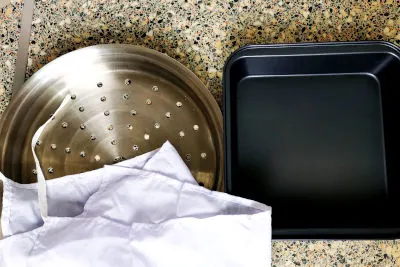
The baking pan method is my choice for homemade rice rolls because I do not need to buy the special Cheung Fun cloth, which is hard to find. Of course, you can make it yourself (100% white thin cotton cloth), but is it worth the time? Furthermore, It is easier to roll the noodle with a nonstick pan than the cloth.
7. The Malaysian version of Cheung Fun
Cheung Fun is also a trendy street food in Malaysia, but with a different type of interpretation.
Some Cheung Fun served at the local hawker stall is not rolled up but did as rice sheets cut into wide noodles. The Penang Chee Cheong Fun is filled with a dipping sauce made of hoisin sauce, peanut sauce, and sweet shrimp paste.
The Kuala Lumpur version is served with yong tau foo on the side and drizzled with soy sauce, sesame seeds, and green onion.
8. How to keep Cheung Fun
Cheung Fun is best to serve while it is fresh. It has a smooth and nearly melts-in-the-mouth texture. It is still good after keeping for some time, although it will firm up slightly.
Keep it in the refrigerator if you want to consume it later. Steams it over high heat for one or two minutes, and the texture is nearly as good as fresh. Do not freeze it because it will alter its texture.

Cheung Fun - How to make steamd rice roll (肠粉)
Cheung fun (肠粉) is on the menu of every Dim Sum restaurant. Cheung fun has a light and soft texture, non-oily, and is served hot right from the steamer. Cheung fun has a light and soft texture, non-oily, and is served hot right from the steamer.
Ingredients
The batter: (A)
- 100g rice flour
- 20g wheat starch
- 1/2 tsp of salt
- 2 tsp of vegetable oil
- 400 ml of water (1.5 cups)
The filling: (B)
- 50g shrimp, shelled
- 1 tbsp scallion, cut into small rings
- 1 tbsp dried shrimps
- 50g char siu
The sauce: (C)
- 3 tbsp light soy sauce
- 1 tbsp dark soy sauce
- 1 tbsp oyster sauce
- 1/4 tsp salt
- 2.5 tbsp sugar
- 1 large tbsp chopped scallion (white part)
- 5 slices ginger
- 9 tbsp water
Instructions
- Mix A in a container.
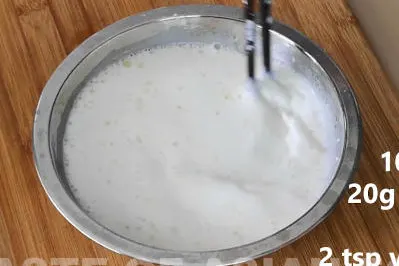
- Set up the steaming station. Bring the water to a boil. Measure 100g of the batter. Stir and pour it into an 8”x8” square pan. Adjust the level of the pan so that the batter is equally distributed.
- Add the filling in B (shrimp, char siu, or scallion with dried shrimp) to one side of the batter.
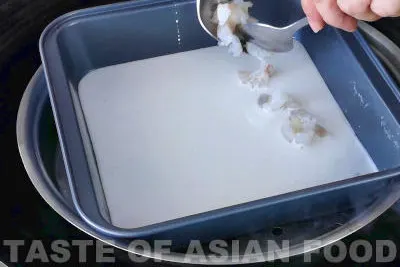
- Cover and steam for 2 minutes or until the rice sheet become translucent.
Let cool for half a minute, then push the noodle sheet with the dough scraper to roll up the noodle.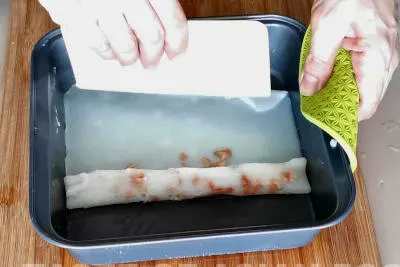
- To make the sauce: add C into a pan. Bring it to a boil, then strain to remove the ginger and scallion.
- Place it on the serving dish and doused with the sauce. Serve.
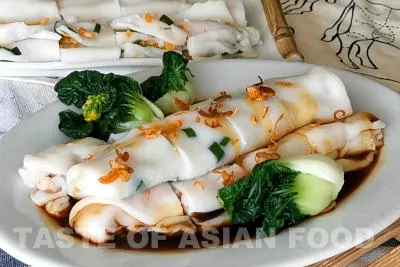
Recommended Products
As an Amazon Associate and member of other affiliate programs, I earn from qualifying purchases.
-
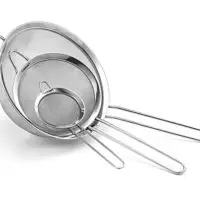 Cuisinart CTG-00-3MS Set of 3 Fine Mesh Stainless Steel Strainers
Cuisinart CTG-00-3MS Set of 3 Fine Mesh Stainless Steel Strainers -
 Simply Calphalon Nonstick Bakeware, Square Cake Pan, 8-inch
Simply Calphalon Nonstick Bakeware, Square Cake Pan, 8-inch -
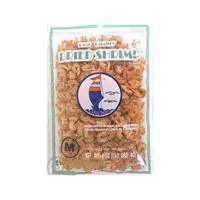 Dried shrimp - 3 oz
Dried shrimp - 3 oz -
 Pro Dough Pastry Scraper/Cutter/Chopper Stainless Steel Mirror Polished with Measuring Scale Multipurpose- Cake, Pizza Cutter - Pastry Bread Separator Scale Knife (1)
Pro Dough Pastry Scraper/Cutter/Chopper Stainless Steel Mirror Polished with Measuring Scale Multipurpose- Cake, Pizza Cutter - Pastry Bread Separator Scale Knife (1)
Nutrition Information:
Yield: 5 Serving Size: 1Amount Per Serving: Calories: 205Total Fat: 3gSaturated Fat: 1gTrans Fat: 0gUnsaturated Fat: 2gCholesterol: 29mgSodium: 1421mgCarbohydrates: 36gFiber: 2gSugar: 8gProtein: 8g
This data was provided and calculated by Nutritionix on 10/1/2020

J
Wednesday 14th of June 2023
Hi,
I really appreciate the detailed, almost scientific recipe. However, I would like to ask about the usage of corn starch. As you said, your rice flour actually contains corn starch. For those of us who use pure rice flour, what amount of corn starch would you recommend? Thanks!
KP Kwan
Saturday 17th of June 2023
You can replace the wheat starch in the recipe with cornstarch. If you decide not to use starch and only rice flour, the texture will be more chewy and less slippery. It is more of the personnel preference of the texture you want to get.
Cc
Monday 19th of September 2022
Thanks so much for a detailed recipe. I could never get the sauce just right.
JP
Tuesday 9th of August 2022
Is it possible to refrigerate unused batter, or will that affect the Cheung fun when steamed?
KP Kwan
Sunday 14th of August 2022
I have not tried to freeze the batter. I am looking forward to knowing the result too. My guess is it should be Ok to do so.
Rosalie L
Saturday 21st of August 2021
Hi, My sister recommended version D of this recipe and I made it with dried shrimp and spring onion, and sauce B. It was easy to follow and produced very delicious cheung fun for 2 people. I used the base of my non stick round springform cake tray (20 cm) which limits the thickness to about 1.5 mm - cooks perfectly within the 2 min specified and made 8 pieces. Thanks for the recipe and hard work in testing for the right consistency and taste!
KP Kwan
Saturday 21st of August 2021
Glad to know that the recipe is useful to you, and thanks for sharing your experience.
K L Ong
Friday 16th of April 2021
I love rice roll and make it often at home. My problem is I find my rice roll quite sticky in texture even though I steamed it for up to 5 min. Could it be due to the aluminium made steaming pan I used that caused it to be sticky as if undercooked? or other reasons?Would appreciate your expert advice. Thanks
KP Kwan
Saturday 17th of April 2021
Hi Ong, I would try the following: - If it is sticky due to too much batter, I will suggest using less so that it cooks through in a shorter time. (thinner) - If it is still too sticky, try to use less water. But I do not think the aluminum pan is the problem. I did use the pan and the cloth method, and they came out nearly identical. If the problem persists, try to get a pan with a non-stick surface. KP Kwan